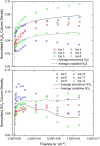Energetic electron irradiations of amorphous and crystalline sulphur-bearing astrochemical ices
- PMID: 36226122
- PMCID: PMC9549411
- DOI: 10.3389/fchem.2022.1003163
Energetic electron irradiations of amorphous and crystalline sulphur-bearing astrochemical ices
Abstract
Laboratory experiments have confirmed that the radiolytic decay rate of astrochemical ice analogues is dependent upon the solid phase of the target ice, with some crystalline molecular ices being more radio-resistant than their amorphous counterparts. The degree of radio-resistance exhibited by crystalline ice phases is dependent upon the nature, strength, and extent of the intermolecular interactions that characterise their solid structure. For example, it has been shown that crystalline CH3OH decays at a significantly slower rate when irradiated by 2 keV electrons at 20 K than does the amorphous phase due to the stabilising effect imparted by the presence of an extensive array of strong hydrogen bonds. These results have important consequences for the astrochemistry of interstellar ices and outer Solar System bodies, as they imply that the chemical products arising from the irradiation of amorphous ices (which may include prebiotic molecules relevant to biology) should be more abundant than those arising from similar irradiations of crystalline phases. In this present study, we have extended our work on this subject by performing comparative energetic electron irradiations of the amorphous and crystalline phases of the sulphur-bearing molecules H2S and SO2 at 20 K. We have found evidence for phase-dependent chemistry in both these species, with the radiation-induced exponential decay of amorphous H2S being more rapid than that of the crystalline phase, similar to the effect that has been previously observed for CH3OH. For SO2, two fluence regimes are apparent: a low-fluence regime in which the crystalline ice exhibits a rapid exponential decay while the amorphous ice possibly resists decay, and a high-fluence regime in which both phases undergo slow exponential-like decays. We have discussed our results in the contexts of interstellar and Solar System ice astrochemistry and the formation of sulphur allotropes and residues in these settings.
Keywords: amorphous ice; astrochemistry; crystalline ice; electron irradiation; planetary science; radiation chemistry; sulphur.
Copyright © 2022 Mifsud, Herczku, Rácz, Rahul, Kovács, Juhász, Sulik, Biri, McCullough, Kaňuchová, Ioppolo, Hailey and Mason.
Conflict of interest statement
The authors declare that the research was conducted in the absence of any commercial or financial relationships that could be construed as a potential conflict of interest.
Figures






References
-
- Bagenal F., Dols V. (2020). The space environment of Io and Europa. JGR. Space Phys. 125, e2019JA027485. 10.1029/2019ja027485 - DOI
-
- Boogert A. C. A., Gerakines P. A., Whittet D. C. B. (2015). Observations of the icy universe. Annu. Rev. Astron. Astrophys. 53, 541–581. 10.1146/annurev-astro-082214-122348 - DOI
-
- Boogert A. C. A., Schutte W. A., Helmich F. P., Tielens A. G. G. M., Wooden D. H. (1997). Infrared observations and laboratory simulations of CH4 and SO2 . Astron. Astrophys. 317, 929.
-
- Boyer M. C., Rivas N., Tran A. A., Verish C. A., Arumainayagam C. R. (2016). The role of low-energy (≤ 20 eV) electrons in astrochemistry. Surf. Sci. 652, 26–32. 10.1016/j.susc.2016.03.012 - DOI
LinkOut - more resources
Full Text Sources

